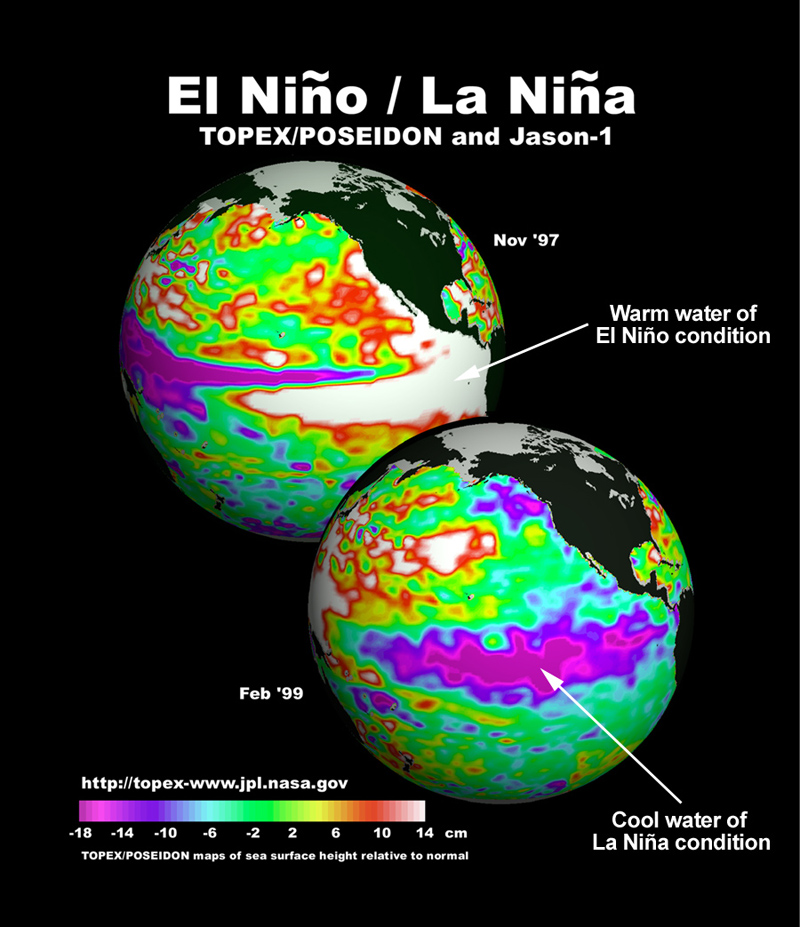El Nino Southern Oscillation (ENSO)
ENSO stands for El Niño/ Southern Oscillation. The ENSO cycle refers to the coherent and sometimes very strong year-to-year variations in sea- surface temperatures, convective rainfall, surface air pressure, and atmospheric circulation that occur across the equatorial Pacific Ocean. El Niño and La Niña represent opposite extremes in the ENSO cycle.
General: El Niño episodes (left hand column) reflect periods of exceptionally warm sea surface temperatures across the eastern tropical Pacific. La Niña episodes (right hand column) represent periods of below-average sea-surface temperatures across the eastern tropical Pacific. These episodes typically last approximately 9-12 months. Sea-surface temperature (top) and departure (bottom) maps for December – February during strong El Niño and La Niña episodes are shown above.
Detailed: During a strong El Niño ocean temperatures can average 2°C – 3.5°C (4°F – 6°F) above normal between the date line and the west coast of South America (bottom left map). These areas of exceptionally warm waters coincide with the regions of above-average tropical rainfall. During La Niña temperatures average 1°C – 3°C (2°F – 6°F) below normal between the date line and the west coast of South America. This large region of below-average temperatures coincides with the area of well below-average tropical rainfall.

Source: NOAA/NWS Climate Prediction Center
For both El Niño and La Niña the tropical rainfall, wind, and air pressure patterns over the equatorial Pacific Ocean are most strongly linked to the underlying sea-surface temperatures, and vice versa, during December-April. During this period the El Niño and La Niña conditions are typically strongest, and have the strongest impacts on U.S. weather patterns.
El Nino and La Niña episodes typically last approximately 9-12 months. They often begin to form during June-August, reach peak strength during December-April, and then decay during May-July of the next year. However, some prolonged episodes have lasted 2 years and even as long as 3-4 years. While their periodicity can be quite irregular, El Niño and La Niña occurs every 3-5 years on average.
Source: NOAA/NWS Climate Prediction Center
The Southern Oscillation and its Link to the ENSO Cycle

Source: NOAA/NWS Climate Prediction Center
The fluctuations in ocean temperatures during El Niño and La Niña are accompanied by even larger-scale fluctuations in air pressure known as the Southern Oscillation. The negative phase of the Southern Oscillation occurs during El Niño episodes, and refers to the situation when abnormally high air pressure covers Indonesia and the western tropical Pacific and abnormally low air pressure covers the eastern tropical Pacific. In contrast, the positive phase of the Southern Oscillation occurs during La Niña episodes, and refers to the situation when abnormally low air pressure covers Indonesia and the western tropical Pacific and abnormally high air pressure covers the eastern tropical Pacific. These opposite phases of the Southern Oscillation are shown above.
Links
- https://www.cpc.noaa.gov/products/analysis_monitoring/ensocycle/enso_cycle.shtml
- https://www.cpc.noaa.gov/products/analysis_monitoring/ensocycle/soilink.shtml
- https://www.cpc.noaa.gov/products/precip/CWlink/MJO/enso.shtml
- https://www.cpc.noaa.gov/products/analysis_monitoring/ensostuff/ensofaq.shtml#CV
- https://faculty.washington.edu/kessler/occasionally-asked-questions.html


